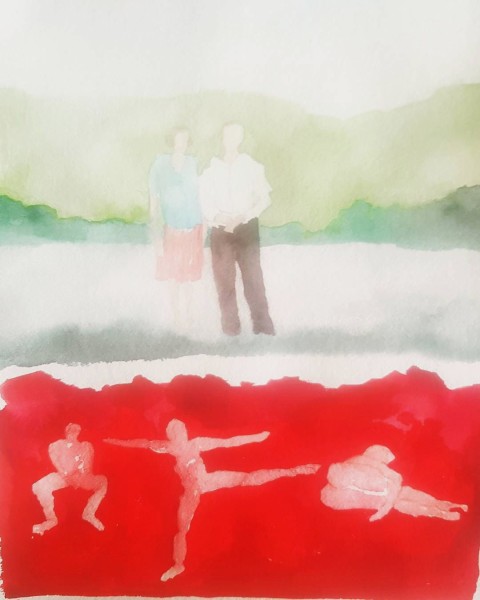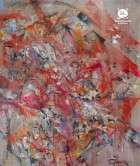Wax
In his stub of a fist is a crayon, thick as an adult thumb, designed for these stubby children who are learning to make marks before they can make words. He hovers the crayon above the paper, wanting to see what he can do, already not wanting to make a mistake. I catch him looking at me as though he might need permission. The crayon is red, always red. Sometimes I ease the green into his palm, trace a tickle across his unlined skin, and watch his fingers curl around the wax stick, the residue of a reflex. Once he realises what pressure can do, he channels all his force, his outrage, his soul, into the act of drawing, grinding circles onto the paper, getting nearer and nearer to the edge. Later, I’ll hook my finger softly into his mouth, where he keeps his kisses, and pull out crushed little red chunks of wax.
Paint
We are in the garden, where spillage and splatter don’t matter. Into three old ice cream tubs I squirt red, blue and black, the colours catching like powder in the back of my throat. Sam is bent double, giggling with the sounds from the bowels of the squashing, spurting bottles. I go first, the paint cold on the sole of my foot. It feeds between my toes, and I remember mud spas and riverbeds. I step from the black paint onto the paper, skidding a little, all my weight, my baby weight, my mother weight, concentrated in the two footprints I’m about to leave. Sam wants his turn; his pats become pushes. I take two steps and turn back to check the silhouette, a Rorschach blot, butterfly wings, bones. I run to the end of the roll of paper, each pair of prints paler than the ones before.
Lead
I’m chopping vegetables for dinner, but I’m also watching him. He sits on the dining chair, his right arm resting on the table, elbow arrowed out. In his left hand he holds the pencil, like an awkward chopstick. His head is bent low and angled, as though he’s listening to the paper, as if it might offer up instructions, but it’s blank and white and silent. I keep on chopping because if I don’t, he’ll remember I’m here. He’ll look at me for help, for more than help – for repair. I chop more carrots than the three of us could ever eat, and then slice each piece in half again. When there is nothing more to chop, I set the knife down.
‘Mum, can you read my writing?’ he asks. I pull up a chair. His pencil is bitten down to the wood; a flake of red paint sits at the corner of his mouth, but he flinches when I reach for it. The words he has written weave and loop across the page, swim above and below the lines.
‘Some,’ I say, running my finger over the letters that twist and knot, dip and slide.
Spray
I’ve stopped asking where he goes. He leaves items for me like roadkill, the tangled carcasses of jeans and unhappy T-shirts trailing up the stairs and across the landing, jamming under his bedroom door when I try to get in. I hear him more than see him, each stair bouncing a tin echo from his backpack, fourteen hollow clinks. He is string limbs and steel toe caps, paint spattered and unlaced. When the door slams, there is a mist of relief left behind, overlaid with helplessness, outlined in guilt. In his room, on the desk we bought him, because we had to do something, are stacked careless, loose-leaf pages of fat, clamouring letters. Every primary-colour word jumps from its own black shadow. I thumb through the sheets, looking for words that might mean me. The markers have penetrated the paper, staining the melamine with half-formed ghost words. His room smells of indelibility and chemicals. At night, sometimes, I think I hear the clack-clack of a can from his room, but it must be a disturbance elsewhere.
Ink
It hurts like bugger at first, more than he said it would, but of course it does; you can’t describe pain, or resurrect it. You can try to paint it, but it never works, not like you can paint love, all of it trapped between the pig’s hair of the brush, stippled onto smiles, oiled onto eyes, gouached, built up, watered down, mixed and tinted. But Sam worked out a way to capture pain, and so here we are, sleeves rolled up. I go first. Sam holds my hand, like his dad did once: fifteen minutes from incision to stitches and an east–west scar Sam will never remember, but which still belongs to him. The needle bites three thousand times a second: my right arm; Sam’s left. Half a butterfly each. The colour seeps and blurs into my middle-aged skin, which gives and pulls. Sam’s skin is taut, applied over muscle and veins that are looped and knotted around my heart. The pain has settled now. It buzzes like an undercurrent – manageable, but, still, it’s a good excuse to cry. When Sam’s tattoo is finished, we bring our forearms together, and the tattooist takes a picture. Sam draws his fingers tight into a fist, as though preparing for a tourniquet, and his wing tenses. I take his hand and the wing stills.

Notes from Guest Reader Elisabeth Ingram Wallace
What I like in ‘Marks’ is the eerie sense of hyper vigilance; the sense of a ghost woman searching outside of her own body for her identity. And I’m not sure she ever does.
The world of this story is marks and scars, and that is what people own here – remainders of things cut out, unwritten.
The woman has a child, but from birth, she is reading him, literally ‘looking for words that might mean me,’ in everything he does.
I think it is fascinating to see a child through this veil of ego and unease. This dislocated thing she must watch, hook at, catch the eye of. A mass to test the weight of her own bones around.
The mother ghosts about and through the white space around the child, and haunts herself.
I admire how restrained it is. It is restrained in the way a good ghost story is, the way ‘The Turn of the Screw’ is – a honed concentration of heavy white space, that Johanna uses to stitch through twenty years in under 1000 words.


 The core workshop of SmokeLong Fitness is all in writing, so you can take part from anywhere at anytime. We are excited about creating a supportive, consistent and structured environment for flash writers to work on their craft in a community. We are thrilled and proud to say that our workshop participants have won, placed, or been listed in every major flash competition. Community works.
The core workshop of SmokeLong Fitness is all in writing, so you can take part from anywhere at anytime. We are excited about creating a supportive, consistent and structured environment for flash writers to work on their craft in a community. We are thrilled and proud to say that our workshop participants have won, placed, or been listed in every major flash competition. Community works.